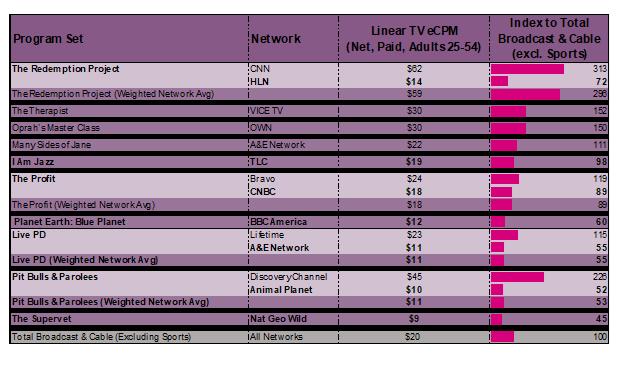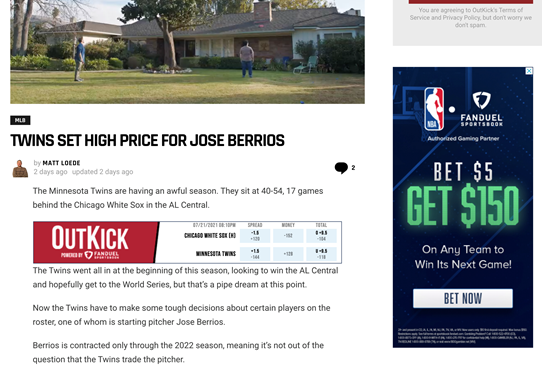How To Make Any Ad Work Harder

"Put it in a resonant context." This was probably intuitively known to advertising practitioners in ancient Egypt. Because it's common sense.
The first time I came across the idea early in my career -- the Mad Men era -- was when I read a paper citing a finding from the radio era. Horace Schwerin, the father of modern ad pretesting, reported that radio ads for foods and beverages performed less well in fear-producing radio programs.
That sent me off on a tack to analyze existing day-after recall scores by Nielsen program types. Results were mixed. Later I realized that the Nielsen program types, as useful as they are, were not subtle enough for this particular task.
Years later Nielsen NCS's Leslie Wood reconfirmed that by showing Nielsen program types only accounted for 2% of ROI results, although sitcoms did consistently outperform (by 10%) other program types for foods & beverages -- echoing Schwerin to some degree.
ARF's then CEO Gayle Fuguitt and ARF's Horst Stipp made context effects a priority subject which it is still is, the work being carried on today by ARF's Cognition Council, which is having a webinar on October 14 I highly recommend, being one of the speakers. The event extends beyond context effects to cover all aspects of ads and contexts which convey positive human values versus the opposite.
That's the thing: ads and contexts work together. The consumer never sees an ad naked except in outdoor. In all other media the ad is seen within the body of some other content, which has a substantial effect on how well or poorly the ad performs.
Horst summarized the accumulated wisdom of a half century of studies of this phenomenon by pointing out two strategies advertisers/agencies can use to get their ads more attention and higher outcomes, including sales and full funnel branding lifts:
- Find programs which draw high attentiveness and place your ad there. This tends to come with a cost since such programs tend to have higher CPMs because everyone knows they get high attention.
- Find programs which thematically/psychologically align with your ad, and put your ad there. This tends to be CPM-neutral. In a case I'll present in the ARF webinar on October 14, the top ten programs most aligned (RMT calls it "Resonance") with a particular P&G spot had a CPM 13% below the average of all entertainment shows on broadcast/cable network television according to Standard Media Index.
SMI President Ben Tatta comments, "The contextual impact of television is truly unrivaled, and by combining RMT 'Resonance' scores with SMI linear eCPM, data buyers and sellers can now directly correlate the contextual impact and effective cost of every placement on the schedule."
The combined SMI/RMT data are extremely helpful in optimizing the brand resonance of linear campaigns by surfacing the most impactful and efficient network and program options available, as we can see in the following table:

Alignment/Resonance is being practiced by RMT in TV and digital programmatically right now, and is soon to expand into radio, audio and podcasts programmatically, so it's not added effort for overworked and underpaid media agencies. Partner Semasio is an AI which brings RMT's work to 22 countries so far.
Another practitioner doing complementary work in the same field is Hindsight, which uses AI to find perfectly aligned ("endemic" is the word that springs to mind) contexts in digital, social, influencer and other media buyable programmatically, so that in microseconds an ad can be inserted into an environment that might just have been posted.
For example, as we all know, legalized sports betting is suddenly a big spender on TV, and here's how an ad was automatically inserted into aligned content by Hindsight, producing excellent results for the client, Outkick:

"By implementing HSV's Adaptive Ad Technology, Outkick is able to deliver contextually relevant sports betting information to our large and loyal audience," said Clint Stapleton, Director of Sports Betting at OutKick. "Not only is this a positive from a user experience perspective, but it also allows us to extract more value out of our sports focused content."
Hindsight, which is quite new, has already launched brands in Music, Fitness, Cosmetics, Sports Apparel and Sports Betting. Its founder, Hersh Patel is in the 2021 Forbes 30 Under 30 list, and deserves to be.
Alignment/Resonance is a virtually "free" trick (i.e., very little cost-add to the CPM) that can now be executed programmatically. RMT third party ROI and branding lift results have been verified in double digits by Nielsen NCS, 605 and Neustar. Hindsight has a number of reference clients to attest to its add-to-return on ad investment.
This simple method, alignment, to amplify the positive impact of your ads is worth a quick programmatic random control experiment. Contextual alignment might be the biggest upside for the least effort and expense across the whole adtech/martech front, which is full of promise and can lead to analysis paralysis. As agile software development teaches us, test early and often.
Click the social buttons to share this story with colleagues and friends.
The opinions expressed here are the author's views and do not necessarily represent the views of MediaVillage.com/MyersBizNet.


